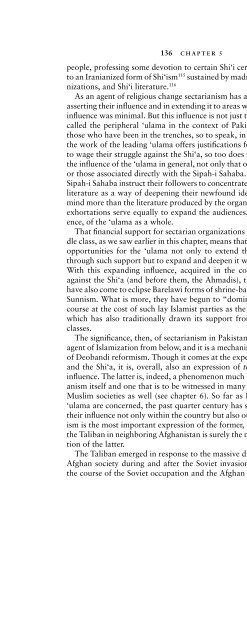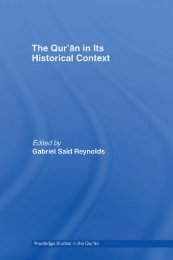Download (1 MB) - Islam and Christian-Muslim Relations: Articles ...
Download (1 MB) - Islam and Christian-Muslim Relations: Articles ...
Download (1 MB) - Islam and Christian-Muslim Relations: Articles ...
You also want an ePaper? Increase the reach of your titles
YUMPU automatically turns print PDFs into web optimized ePapers that Google loves.
136 CHAPTER 5people, professing some devotion to certain Shi‘i ceremonies <strong>and</strong> rituals,to an Iranianized form of Shi‘ism 115 sustained by madrasas, sectarian organizations,<strong>and</strong> Shi‘i literature. 116As an agent of religious change sectarianism has assisted the ‘ulama inasserting their influence <strong>and</strong> in extending it to areas where previously suchinfluence was minimal. But this influence is not just that of those we havecalled the peripheral ‘ulama in the context of Pakistani sectarianism—those who have been in the trenches, so to speak, in this struggle. Just asthe work of the leading ‘ulama offers justifications for the radical Sunnisto wage their struggle against the Shi‘a, so too does that struggle exp<strong>and</strong>the influence of the ‘ulama in general, not only that of the peripheral onesor those associated directly with the Sipah-i Sahaba. When leaders of theSipah-i Sahaba instruct their followers to concentrate on reading religiousliterature as a way of deepening their newfound identities, they have inmind more than the literature produced by the organization itself. 117 Suchexhortations serve equally to exp<strong>and</strong> the audiences, the sphere of influence,of the ‘ulama as a whole.That financial support for sectarian organizations comes from the middleclass, as we saw earlier in this chapter, means that sectarianism createsopportunities for the ‘ulama not only to extend their reach in societythrough such support but to exp<strong>and</strong> <strong>and</strong> deepen it within this class itself.With this exp<strong>and</strong>ing influence, acquired in the course of the struggleagainst the Shi‘a (<strong>and</strong> before them, the Ahmadis), the Deob<strong>and</strong>i ‘ulamahave also come to eclipse Barelawi forms of shrine-based religiosity withinSunnism. What is more, they have begun to “dominate the <strong>Islam</strong>ist discourseat the cost of such lay <strong>Islam</strong>ist parties as the Jama‘at-i <strong>Islam</strong>i,” 118which has also traditionally drawn its support from the urban middleclasses.The significance, then, of sectarianism in Pakistan is manifold. It is anagent of <strong>Islam</strong>ization from below, <strong>and</strong> it is a mechanism for the expansionof Deob<strong>and</strong>i reformism. Though it comes at the expense of the Barelawis<strong>and</strong> the Shi‘a, it is, overall, also an expression of the ‘ulama’s growinginfluence. The latter is, indeed, a phenomenon much broader than sectarianismitself <strong>and</strong> one that is to be witnessed in many other contemporary<strong>Muslim</strong> societies as well (see chapter 6). So far as Pakistan’s Deob<strong>and</strong>i‘ulama are concerned, the past quarter century has seen an expansion oftheir influence not only within the country but also outside it. If sectarianismis the most important expression of the former, the strange career ofthe Taliban in neighboring Afghanistan is surely the most striking illustrationof the latter.The Taliban emerged in response to the massive dislocations caused inAfghan society during <strong>and</strong> after the Soviet invasion of 1979. 119 Duringthe course of the Soviet occupation <strong>and</strong> the Afghan resistance against it,



